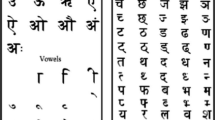Abstract
In the present paper, we used the Pixel Plot and Trace and Re-plot and Re-trace (PPTRPRT) technique for English offline handwritten curve scripts and leads. Unlike other approaches, the PPTRPRT technique prioritizes segmentation of words and characters. The PPTRPRT technique extracts text regions from English offline handwritten cursive scripts and leads an iterative procedure for segmentation of text lines along with skew and de-skew operations. Iteration outcomes provide for pixel space-based word segmentation which enables segmentation of characters. The PPTRPRT technique embraces various dispensations in segmentation of characters from English offline handwritten cursive scripts. Moreover, various normalization steps allow for deviations in pen breadth and inscription slant. Investigational outcomes show that the proposed technique is competent at extracting characters from English offline handwritten cursive scripts.













Similar content being viewed by others
References
Salvi D, Zhou J, Waggoner J, Wang S (2013) Handwritten text segmentation using average longest path algorithm. In: Workshop on applications of computer vision (WACV), IEEE, ISBN 978-1-4673-5053-2, pp 505–512
Sarkar R, Halder S, Malakar S, Das N, Basu S, Nasipuri M (2012) Text line extraction from handwritten document pages based on line contour estimation. In: 3rd international conference on computing communication and networking technologies (ICCCNT), IEEE, INSPEC 13252116, pp 1–8
Impedovo S, Facchini G, Mangini FM (2012) A new cursive basic word database for bank-check processing systems. In: 10th IAPR international workshop on document analysis systems (DAS), IEEE, ISBN 978-1-4673-0868-7, pp 450–454
Lee H, Verma B (2010) Over-segmentation and neural binary validation for cursive handwriting recognition. In: International joint conference on neural networks (IJCNN), IEEE, ISBN 978-1-4244-6916-1, pp 1–5
Luthy F, Varga T, Bunke H (2007) Using hidden markov models as a tool for handwritten text line segmentation. In: Ninth international conference on document analysis and recognition (ICDAR 2007), IEEE, ISBN 978-0-7695-2822-9, p 8
Njah S, Nouma BB, Bezine H, Alimi AM (2012) MAYASTROUN: Multilanguage handwriting database. In: International conference on frontiers in handwriting recognition (ICFHR), IEEE, ISBN 978-1-4673-2262-1, pp 308–312
Shivram A, Zhu B, Setlur S, Nkagawa M (2013) Segmentation-based online word recognition: a conditional random field driven beam search strategy. In: 12th International conference on document analysis and recognition (ICDAR), IEEE, ISSN 1520-5363, pp 852–856
Zhu B, Shivram A, Setlur S, Govindaraju V, Nakagawa M (2013) Online handwritten cursive word recognition using segmentation-free MRF in combination with P2DBMN-MQDF. In: 12th international conference on document analysis and recognition (ICDAR), IEEE, ISSN 1520-5363, pp 349–353
Bezerra BLD, Zanchettin C, Bragad de Andrade V (2012) A hybrid RNN Model for cursive offline handwriting recognition.In: Brazilian symposium on neural networks (SBRN), IEEE, ISBN 978-1-4673-2641-4, pp 113–118
Stamatopoulos N, Gatos B, Louloudis G, Pal U (2013) Handwriting segmentation contest. In: 12th international conference on document analysis and recognition (ICDAR), IEEE, ISSN 1520-5363, pp 1402–1406
Pradeep J, Srinivasan E, Himavathi S (2012) Performance analysis of hybrid feature extraction technique for recognizing English handwritten characters. In: World Congress on Information and Communication Technologies (WICT), IEEE, ISBN 978-1-4673-4806-5, pp 373–377
Yuan A, Bai G, Yang P, Guo Y (2012) Handwritten english word recognition based on convolution neural networks. In: International conference on frontiers in handwriting recognition (ICFHR), IEEE, ISBN 978-1-4673-2262-1, pp 207–212
Gilliam T, Wilson RC, Clark John A (2011) Segmentation and normalisation in grapheme codebooks. In: International conference on document analysis and recognition (ICDAR), IEEE, ISBN 978-1-4577-1350-7, pp 613–61
Ryu J, Koo HI, Cho NI (2015) Word segmentation method for handwritten documents based on structured learning. IEEE Trans Signal Process Lett 22(8)
Sharma MK, Dhaka VP (2015) An efficient segmentation technique for Devanagari offline handwritten scripts using the Feedforward Neural Network. Neural Comput Appl. doi:10.1007/s00521-015-1844-9
Dhaka VP, Sharma MK (2015) Classification of image using a genetic general neural decision treeInt. J Appl Pattern Recogn 21:76–95
Obaidullah SM, Mondal A, Roy K (2014) Structural feature-based approach for script identification from printed Indian document. In: IEEE international conference on signal processing and integrated networks (SPIN), pp 120–124
Zhu G (2009) Language and Media Process. Laboratory, University of Maryland, College Park, MD, USA. In: Zheng Y, Doermann D, Jaeger S (eds) Signature detection and matching for document image retrieval, IEEE transaction on pattern analysis and machine intelligence, 31(11): 2015–2031
You J (2003) Department of Computer, Hong Kong Polytechnic University, Kowloon. In: Zhang D, Cao J, Guo M (eds) Parallel biometrics computing using mobile agents, IEEE international conference on parallel processing, pp 305–312
Pervouchine V (2005) School of Computer Engineering, Nanyang Technology University, Singapore. In: Leedham G (ed) Document examiner feature extraction: thinned vs. skeletonised handwriting images, TENCON 2005 IEEE Region 10, pp 1–6
Tomai CI (2004) Department of computer science and engineering, center of excellence for document analysis and recognition, Amherst, MA, USA. In: Zhang B, Srihari SN (eds) Discriminatory power of handwritten words for writer recognition”, Proceedings of the 17th International Conference on Pattern Recognition, ICPR 2004, vol 2, pp 638–641
Jiang Y, Ding X, Fu Q, Ren Z (2006) Context driven chinese string segmentation and recognition. In: Proceedings structural, syntactic, and statistical pattern recognition: joint IAPR Int’l Workshops, pp 127–135
Gatos B, Louloudis G, Pratikakis I, Halatsis C (2009) Text line and word segmentation ofhandwritten documents. Pattern Recogn 42(12):3169–3183
Stafylakis T, Papavassiliou V, Katsouros V, Carayann G (2010) Handwritten document image segmentation into text lines and words. Pattern Recogn 43(1):369–377
Sharma MK, Dhaka VP (2015) Pixel plot and trace based segmentation method for bilingual handwritten scripts using feedforward neural network. Neural Comput Appl. doi:10.1007/s00521-015-1972-2
Author information
Authors and Affiliations
Corresponding author
Rights and permissions
About this article
Cite this article
Sharma, M.K., Dhaka, V.P. Segmentation of english Offline handwritten cursive scripts using a feedforward neural network. Neural Comput & Applic 27, 1369–1379 (2016). https://doi.org/10.1007/s00521-015-1940-x
Received:
Accepted:
Published:
Issue Date:
DOI: https://doi.org/10.1007/s00521-015-1940-x




